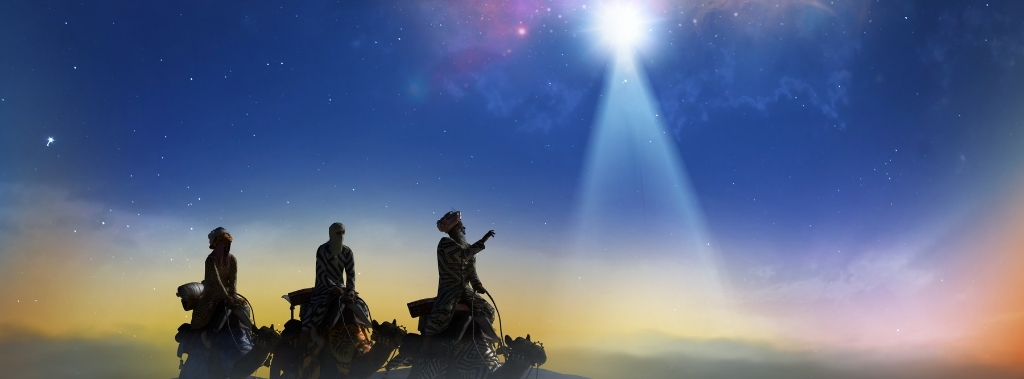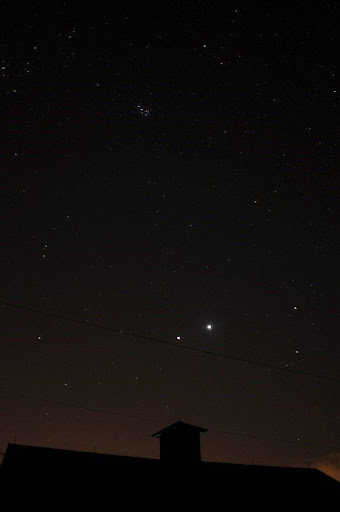Star in the East
“Now after Jesus was born in Bethlehem of Judea in the days of Herod the king, behold, wise men from the East came to Jerusalem, saying, ‘Where is He who has been born King of the Jews? For we have seen His star in the East and have come to worship Him’”
“…they departed; and behold, the star which they had seen in the East went before them, till it came and stood over where the young Child was. When they saw the star, they rejoiced with exceedingly great joy. And when they had come into the house, they saw the young Child with Mary His mother, and fell down and worshiped Him. And when they had opened their treasures, they presented gifts to Him: gold, frankincense, and myrrh.”
—Matthew 2:1-2 & 9-11
Throughout the months of November and December, we are inundated with stores filled with Santa-themed Christmas décor, candy, and even songs. But for most Believers, the focus surrounding the Christmas season is centered around the birth of our Savior—Jesus Christ.
The Star in the East and the Wise Men
Of the many songs sung during this season, a familiar one is about the three kings—known as wise men, or magi—who followed the star mentioned in Matthew 2. This star in the East is used as a decorative reminder of the place of our Savior’s birth.
According to this account, the wise men found the young Child with Mary His mother in a house, indicating that by the time they reached Him, Mary and Joseph had left the manger, but not Bethlehem.

Yet, what was the significance of this star in the East? Who were the men who followed after it?
While we understand from scripture that wise men from the East traveled to honor and witness the King of the Jews, it never mentions that there were exactly three wise men. Therefore, we can only speculate that the number three was assumed throughout the centuries because of the number of gifts brought with them (gold, frankincense, and myrrh) and not an actual biblically given number.
Regardless, the wise men who came to worship Jesus had only these few resources and skills at their disposal in order to pinpoint the exact location of the Child:
- A knowledge of the stars and skies and how they relate to prophecy—they could interpret the sky
- A knowledge of prophecies given over the generations—such as those found in the books of Isaiah and Malachi
- The ability to interpret prophecy, dreams, and signs in general–be they kings, wise men, or both, they were educated
- Their wealth may have given them access to people and information they would not have otherwise had
Therefore, these men came to worship Jesus based on their ability to read the signs and know the timing of prophecy.

The Star in the East Guided the Wise Men
However, what of the prophecy that led them? From Isaiah to Malachi—even possibly a lost prophecy of Daniel—and beyond, there are many within the Scriptures. So then, which ones did they use?
While we do not know the exact prophecy/prophecies they followed, we know that they could never have found the King without the star in the East to guide them. Yet, of the sign in the sky that led them to Jesus, we do know a little more about…
There is of course the possibility that God placed the star in the East in the sky and then removed it after then wise men came, but there is also the possibility of a God-timed astrological phenomenon.
Signs, Knowledge, and Wisdom | 7 Possibilities for the Star in the East
With the possibilities of astrological phenomenon combined with the knowledge of these men, we do know a few things:
- First, we know that the sign they saw would almost certainly have indicated an important birth in general—quite probably the birth of a king—to most wise men of the time.
Yet, we also know that even Herod’s wise men did not notice or fully understand the signs, and that prophecy and Godly wisdom were what allowed these men to know that they were looking for the King of the Jews—our Messiah.
- Second, the word, “aster,” which has traditionally been translated in the Word to mean “star,” can also mean almost any heavenly body. This means it could indeed have been a star they were referencing, but it could also refer to a planet, comet, meteor, or another usually nighttime phenomenon.
- Third, given the astrological information we now have available, the star may have been a rare sighting of a planet rising before the sun. Many believe this planet to have been Jupiter since that planet was associated with kings.
If this is the case, each late evening/early morning that the planet—star in the East—was sighted after its initial helical rising would have lasted only briefly before being concealed by the sun. This also would show us one of the reasons why the Word refers to it as ‘star in the East,’ since the sun rising in the east would have been the object to obscure the view, and the planet may have risen in the east—thus, while the men almost certainly came from the east, there is a chance this is more in reference to the ‘star.’
- Fourth, related to the above point, it could have been a single planet seen during the night and not so swiftly concealed. A single planet without any additional signs would be less likely to be the ‘aster’ seen. However, if combined with other nighttime phenomena or unique placement and proximity to the Earth, it could have been the star in the East.
- Fifth, related to these single planet theories, it could have been two or more planets in conjunction, not necessarily seen mere moments before being obscured by the rising sun, but seen for a longer period of time within the night’s sky.
An example of a planet conjunction occurred between Jupiter and Venus on June 17, 2 B.C., when the planets met so closely in the sky that they appeared to be a single object. Dates such as this are close to when we believe Jesus to have been born. This example lends enough time for Jesus to have been moved to a house, yet other planets also appear closely together at varying dates between 3-2 B.C., such as Mercury and Saturn, Saturn and Venus, etc.. Additionally, there were several occasions during this same time period when three planets came together, once even forming a bright star-like triangle.
Yet, while events like these would visually be close to how we tend to imagine the star in the East that these men followed, its appearance would not last as long since each planet has its trajectory, making it more difficult to follow than a single planet traversing the sky. Unless they saw a conjunction of planets and then followed one, possibly Jupiter, as it was known as a “king aster,” and thereby still being led to Jesus after witnessing an awe-inspiring astrological sight.

- Sixth, if it were a single planet, over time—a little every day—after the initial heliacal rising, it would have moved along the horizon, giving a sort of direction the men may have followed.
If it were two or more planets, they would not likely follow the same direction long enough to use ALL as a guide—the men would have had to have chosen which they considered to be closely connected to the birth of the Messiah.
Either way, if any planets were visible for consecutive nights, they could have followed them.
- Seventh, there is a point when planets orbiting may appear to ‘change direction’ as their orbit, and ours differ. Instead of traveling east to west, the planet could ‘shift’ and move west on the horizon. Thus, the star in the East hovering over the place of Jesus’ birth could have been related to this phenomenon; either due to the planet’s orbit staying in one place on the horizon for longer to the naked eye, or, because as it changed direction the last place it was before it moved would have been what the men considered to be the place of hovering, i.e. where they were led to by following the planet.
Additionally, visual effects, like “retrograde motion,” could have made a planet, such as Jupiter appear to be stopped. This appearance, along with those described above, could easily have someone explaining the ‘aster’ as stopping over a location.
These events combined—particularly if they were also focusing on the placement of the stars in general—would have been rare. Yet, God has the power to have planned the timing down to the minute. There are two thoughts about this astrological phenomenon. Thought one is that the sign would have had to appear in the sky months before Jesus’ birth so that they could reach Him near the time of His birth. However, this is hardly an issue since He is not described as being located in the manger when they reach Him. The other is that the initial heliacal rising occurred on the day of Jesus’ birth and that they did not reach Him until He was several months old.
Of these options, which most likely, depends on what age we believe Jesus to be when they arrived. If He was birthed within hours or weeks of their arrival, the first option is perhaps more likely. If He was many weeks or months old when they arrived, then the second option would be more likely. Both depend in part on how long it was before Joseph and Mary took Jesus from Bethlehem. If before they hid in Egypt, they took Jesus to the Temple in Jerusalem at 40 days, as was often custom, then the first option would have to be more likely…
In any case, we cannot know for certain if God crafted a star in the East just for the occasion or if He ordered the timing of the planets’ orbits to create the necessary sign in the sky. Either way, the star in the East plays an important role and indeed is befitting of the King of kings’ birth. It led these wise men, or kings, to the side of Jesus. It lets those who had eyes to see and ears to hear, know that the Messiah had come… and, as it says in Psalm 148:3, “Praise Him, sun and moon; Praise Him, all you stars of light!”
All creation was made by God. Therefore, surely the stars—the planets and all the heavenly bodies—would worship the birth of the Son of God. Surely, too, at this season when the birth of Jesus is so fresh in our minds, we too should worship Him as the stars, like those wise men of old. Gifting our Savior with the gift of our praise as we revel in His goodness—our salvation and His glory in the stars are both signs of His unending love.